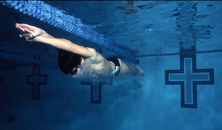As a former competitive swimmer in high school (ages ago), and after having two kids on competitive swim teams (more recent, but 1980s) I have a few insights.
The first is that competitive swimmers these days put in hours per day swimming. Some are swimming well over 10,000 yards per day, in two practices (morning and afternoon). In order for the breast stroke to be effective, it needs a very powerful kick. This includes what is called almost a "whip kick" in which the legs are very, very aggressively brought together at the end of the kick cycle. This is probably what is causing the problems with competitive breast stroke swimmers.
Diving is totally different, as the kick is nowhere near what a competitive swimmer does. The frog kick varies dramatically from what a competitive swimmer does too, as the kick is not really powerful. That would stir up the water more than frog kicking divers want. The frog kick is a kick above the plane of the diver horizontally, in order to keep any disturbance from water flow off the bottom (so as not to stir up the bottom in caves and wrecks). This is far different from competitive swimmers, who drop the legs a bit, and if it were in open water their kick would probably stir up the bottom, as some use a dolphin kick within the breast stroke kick.
We (my wife and I) were concerned enough that we recommended that my younger son, a Junior Nationals Swimmer, not seek a swimming scholarship, and instead concentrate on an academic scholarship when applying to college. We were concerned about the extremely high amount of time spent swimming (4+ hours/day). So my sons got their degrees based upon academic, rather than athletic, abilities.
SeaRat









